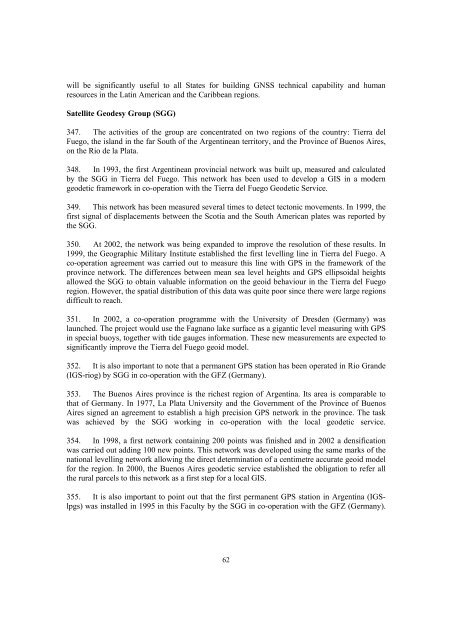will be significantly useful to all States for building GNSS technical capability and humanresources in <str<strong>on</strong>g>the</str<strong>on</strong>g> Latin American and <str<strong>on</strong>g>the</str<strong>on</strong>g> Caribbean regi<strong>on</strong>s.Satellite Geodesy Group (SGG)347. The activities <str<strong>on</strong>g>of</str<strong>on</strong>g> <str<strong>on</strong>g>the</str<strong>on</strong>g> group are c<strong>on</strong>centrated <strong>on</strong> two regi<strong>on</strong>s <str<strong>on</strong>g>of</str<strong>on</strong>g> <str<strong>on</strong>g>the</str<strong>on</strong>g> country: Tierra delFuego, <str<strong>on</strong>g>the</str<strong>on</strong>g> island in <str<strong>on</strong>g>the</str<strong>on</strong>g> far South <str<strong>on</strong>g>of</str<strong>on</strong>g> <str<strong>on</strong>g>the</str<strong>on</strong>g> Argentinean territory, and <str<strong>on</strong>g>the</str<strong>on</strong>g> Province <str<strong>on</strong>g>of</str<strong>on</strong>g> Buenos Aires,<strong>on</strong> <str<strong>on</strong>g>the</str<strong>on</strong>g> Rio de la Plata.348. In 1993, <str<strong>on</strong>g>the</str<strong>on</strong>g> first Argentinean provincial network was built up, measured and calculatedby <str<strong>on</strong>g>the</str<strong>on</strong>g> SGG in Tierra del Fuego. This network has been used to develop a GIS in a moderngeodetic framework in co-operati<strong>on</strong> with <str<strong>on</strong>g>the</str<strong>on</strong>g> Tierra del Fuego Geodetic Service.349. This network has been measured several times to detect tect<strong>on</strong>ic movements. In 1999, <str<strong>on</strong>g>the</str<strong>on</strong>g>first signal <str<strong>on</strong>g>of</str<strong>on</strong>g> displacements between <str<strong>on</strong>g>the</str<strong>on</strong>g> Scotia and <str<strong>on</strong>g>the</str<strong>on</strong>g> South American plates was <str<strong>on</strong>g>report</str<strong>on</strong>g>ed by<str<strong>on</strong>g>the</str<strong>on</strong>g> SGG.350. At 2002, <str<strong>on</strong>g>the</str<strong>on</strong>g> network was being expanded to improve <str<strong>on</strong>g>the</str<strong>on</strong>g> resoluti<strong>on</strong> <str<strong>on</strong>g>of</str<strong>on</strong>g> <str<strong>on</strong>g>the</str<strong>on</strong>g>se results. In1999, <str<strong>on</strong>g>the</str<strong>on</strong>g> Geographic Military Institute established <str<strong>on</strong>g>the</str<strong>on</strong>g> first levelling line in Tierra del Fuego. Aco-operati<strong>on</strong> agreement was carried out to measure this line with GPS in <str<strong>on</strong>g>the</str<strong>on</strong>g> framework <str<strong>on</strong>g>of</str<strong>on</strong>g> <str<strong>on</strong>g>the</str<strong>on</strong>g>province network. The differences between mean sea level heights and GPS ellipsoidal heightsallowed <str<strong>on</strong>g>the</str<strong>on</strong>g> SGG to obtain valuable informati<strong>on</strong> <strong>on</strong> <str<strong>on</strong>g>the</str<strong>on</strong>g> geoid behaviour in <str<strong>on</strong>g>the</str<strong>on</strong>g> Tierra del Fuegoregi<strong>on</strong>. However, <str<strong>on</strong>g>the</str<strong>on</strong>g> spatial distributi<strong>on</strong> <str<strong>on</strong>g>of</str<strong>on</strong>g> this data was quite poor since <str<strong>on</strong>g>the</str<strong>on</strong>g>re were large regi<strong>on</strong>sdifficult to reach.351. In 2002, a co-operati<strong>on</strong> programme with <str<strong>on</strong>g>the</str<strong>on</strong>g> University <str<strong>on</strong>g>of</str<strong>on</strong>g> Dresden (Germany) waslaunched. The project would use <str<strong>on</strong>g>the</str<strong>on</strong>g> Fagnano lake surface as a gigantic level measuring with GPSin special buoys, toge<str<strong>on</strong>g>the</str<strong>on</strong>g>r with tide gauges informati<strong>on</strong>. These new measurements are expected tosignificantly improve <str<strong>on</strong>g>the</str<strong>on</strong>g> Tierra del Fuego geoid model.352. It is also important to note that a permanent GPS stati<strong>on</strong> has been operated in Rio Grande(IGS-riog) by SGG in co-operati<strong>on</strong> with <str<strong>on</strong>g>the</str<strong>on</strong>g> GFZ (Germany).353. The Buenos Aires province is <str<strong>on</strong>g>the</str<strong>on</strong>g> richest regi<strong>on</strong> <str<strong>on</strong>g>of</str<strong>on</strong>g> Argentina. Its area is comparable tothat <str<strong>on</strong>g>of</str<strong>on</strong>g> Germany. In 1977, La Plata University and <str<strong>on</strong>g>the</str<strong>on</strong>g> Government <str<strong>on</strong>g>of</str<strong>on</strong>g> <str<strong>on</strong>g>the</str<strong>on</strong>g> Province <str<strong>on</strong>g>of</str<strong>on</strong>g> BuenosAires signed an agreement to establish a high precisi<strong>on</strong> GPS network in <str<strong>on</strong>g>the</str<strong>on</strong>g> province. The taskwas achieved by <str<strong>on</strong>g>the</str<strong>on</strong>g> SGG working in co-operati<strong>on</strong> with <str<strong>on</strong>g>the</str<strong>on</strong>g> local geodetic service.354. In 1998, a first network c<strong>on</strong>taining 200 points was finished and in 2002 a densificati<strong>on</strong>was carried out adding 100 new points. This network was developed using <str<strong>on</strong>g>the</str<strong>on</strong>g> same marks <str<strong>on</strong>g>of</str<strong>on</strong>g> <str<strong>on</strong>g>the</str<strong>on</strong>g>nati<strong>on</strong>al levelling network allowing <str<strong>on</strong>g>the</str<strong>on</strong>g> direct determinati<strong>on</strong> <str<strong>on</strong>g>of</str<strong>on</strong>g> a centimetre accurate geoid modelfor <str<strong>on</strong>g>the</str<strong>on</strong>g> regi<strong>on</strong>. In 2000, <str<strong>on</strong>g>the</str<strong>on</strong>g> Buenos Aires geodetic service established <str<strong>on</strong>g>the</str<strong>on</strong>g> obligati<strong>on</strong> to refer all<str<strong>on</strong>g>the</str<strong>on</strong>g> rural parcels to this network as a first step for a local GIS.355. It is also important to point out that <str<strong>on</strong>g>the</str<strong>on</strong>g> first permanent GPS stati<strong>on</strong> in Argentina (IGSlpgs)was installed in 1995 in this Faculty by <str<strong>on</strong>g>the</str<strong>on</strong>g> SGG in co-operati<strong>on</strong> with <str<strong>on</strong>g>the</str<strong>on</strong>g> GFZ (Germany).62
356. O<str<strong>on</strong>g>the</str<strong>on</strong>g>r activities <str<strong>on</strong>g>of</str<strong>on</strong>g> <str<strong>on</strong>g>the</str<strong>on</strong>g> Group:• Measurements and process <str<strong>on</strong>g>of</str<strong>on</strong>g> about 300 sites al<strong>on</strong>g <str<strong>on</strong>g>the</str<strong>on</strong>g> Argentinean coastline to define<str<strong>on</strong>g>the</str<strong>on</strong>g> 200 miles marine border by co-ordinates (in co-operati<strong>on</strong> with <str<strong>on</strong>g>the</str<strong>on</strong>g> HydrographicNaval Service);• Co-operati<strong>on</strong> in several scientific campaigns (SAGA in co-operati<strong>on</strong> with GFZ, San Juantect<strong>on</strong>ic displacements with <str<strong>on</strong>g>the</str<strong>on</strong>g> San Juan Nati<strong>on</strong>al University, Central Andes Project for<str<strong>on</strong>g>the</str<strong>on</strong>g> Memphis University, etc.);• Several GPS services (to georeference <strong>satellite</strong> images, photogrametric plates, to establishlocal reference frames, to validate GPS equipment, etc.); and• About 20 courses <strong>on</strong> GPS applicati<strong>on</strong>s <strong>on</strong> different fields.Georreferenciación Satelital (GESA)357. In Argentina, <str<strong>on</strong>g>the</str<strong>on</strong>g> GNSS activities developed by <str<strong>on</strong>g>the</str<strong>on</strong>g> group GESA (GeorreferenciaciónSatelital) in <str<strong>on</strong>g>the</str<strong>on</strong>g> last fifteen years in <str<strong>on</strong>g>the</str<strong>on</strong>g> country are described in this <str<strong>on</strong>g>report</str<strong>on</strong>g>. GESA is a group <str<strong>on</strong>g>of</str<strong>on</strong>g><str<strong>on</strong>g>the</str<strong>on</strong>g> La Plata University specialized in <str<strong>on</strong>g>the</str<strong>on</strong>g> applicati<strong>on</strong> <str<strong>on</strong>g>of</str<strong>on</strong>g> GNSS to scientific research, innovati<strong>on</strong>and technology transfer to <str<strong>on</strong>g>the</str<strong>on</strong>g> private sector through <str<strong>on</strong>g>the</str<strong>on</strong>g> provisi<strong>on</strong> <str<strong>on</strong>g>of</str<strong>on</strong>g> high-quality services. Ouractivities are developed at <str<strong>on</strong>g>the</str<strong>on</strong>g> Faculty <str<strong>on</strong>g>of</str<strong>on</strong>g> Astr<strong>on</strong>omical and Geophysical Sciences (FCAG,Facultad de Ciencias Astr<strong>on</strong>ómicas y Ge<str<strong>on</strong>g>of</str<strong>on</strong>g>ísicas) <str<strong>on</strong>g>of</str<strong>on</strong>g> <str<strong>on</strong>g>the</str<strong>on</strong>g> La Plata Nati<strong>on</strong>al University (UNLP,Universidad Naci<strong>on</strong>al de La Plata). The group was created in 1988 and its first goal was to spreadGNSS techniques in <str<strong>on</strong>g>the</str<strong>on</strong>g> university and <str<strong>on</strong>g>the</str<strong>on</strong>g> local surveyors. The first Nati<strong>on</strong>al Seminar <strong>on</strong> GPSwas organized in 1988 with <str<strong>on</strong>g>the</str<strong>on</strong>g> co-operati<strong>on</strong> <str<strong>on</strong>g>of</str<strong>on</strong>g> o<str<strong>on</strong>g>the</str<strong>on</strong>g>r members <str<strong>on</strong>g>of</str<strong>on</strong>g> <str<strong>on</strong>g>the</str<strong>on</strong>g> FCAG.358. An important achievement has been <str<strong>on</strong>g>the</str<strong>on</strong>g> design <str<strong>on</strong>g>of</str<strong>on</strong>g> a nati<strong>on</strong>al survey network with morethan <strong>on</strong>e hundred points based <strong>on</strong> <str<strong>on</strong>g>the</str<strong>on</strong>g> new techniques. This has been made possible thanks to anagreement between <str<strong>on</strong>g>the</str<strong>on</strong>g> Military Geographic Institute <str<strong>on</strong>g>of</str<strong>on</strong>g> Argentina (IGM, Instituto GeográficoMilitar) and <str<strong>on</strong>g>the</str<strong>on</strong>g> American University c<strong>on</strong>sortium UNAVCO. The potentiality <str<strong>on</strong>g>of</str<strong>on</strong>g> this networkinterested <str<strong>on</strong>g>the</str<strong>on</strong>g> “Ec<strong>on</strong>omic development and financial cleanse Project for <str<strong>on</strong>g>the</str<strong>on</strong>g> ArgentineanProvinces” (Proyecto de Saneamiento Financiero y Desarrollo Ec<strong>on</strong>ómico de las ProvinciasArgentinas). Such project asked GESA to perform <str<strong>on</strong>g>the</str<strong>on</strong>g> calculati<strong>on</strong> and compensati<strong>on</strong> <str<strong>on</strong>g>of</str<strong>on</strong>g> <str<strong>on</strong>g>the</str<strong>on</strong>g> netthat became <str<strong>on</strong>g>the</str<strong>on</strong>g> present Nati<strong>on</strong>al Geodetic Reference System POSGAR 94 (IGM resoluti<strong>on</strong>13/97).359. Since 1992, members <str<strong>on</strong>g>of</str<strong>on</strong>g> GESA give lectures <strong>on</strong> GNSS in different regi<strong>on</strong>s <str<strong>on</strong>g>of</str<strong>on</strong>g> Argentina.The attendees come mostly from universities and survey organizati<strong>on</strong>s.All <str<strong>on</strong>g>the</str<strong>on</strong>g> members <str<strong>on</strong>g>of</str<strong>on</strong>g> GESA participate in scientific projects undertaken in co-operati<strong>on</strong> withprestigious universities and internati<strong>on</strong>al research centres. Since 1994, GESA has established cooperati<strong>on</strong>with <str<strong>on</strong>g>the</str<strong>on</strong>g> Institut für Navigati<strong>on</strong> (Stuttgart University, Germany), <str<strong>on</strong>g>the</str<strong>on</strong>g> DeutschesGeodätisches Forschungsinstitut (München, Germany), Observatoire de Paris (Paris, France), <str<strong>on</strong>g>the</str<strong>on</strong>g>Technische Universität (TU Wien, Vienna, Austria) and <str<strong>on</strong>g>the</str<strong>on</strong>g> Aer<strong>on</strong>omy and Radio-Propagati<strong>on</strong>Laboratory Abdous Salam Internati<strong>on</strong>al Center for Theoretical Physics (ICTP), (Trieste, Italy).Several graduate and postgraduate students developed <str<strong>on</strong>g>the</str<strong>on</strong>g>ir Ph.D.s or <str<strong>on</strong>g>the</str<strong>on</strong>g>ir research work under<str<strong>on</strong>g>the</str<strong>on</strong>g> directi<strong>on</strong> <str<strong>on</strong>g>of</str<strong>on</strong>g> GESA scientists. GESA members have a c<strong>on</strong>siderable experience providingtechnical services to <str<strong>on</strong>g>of</str<strong>on</strong>g>ficial instituti<strong>on</strong>s and private enterprises by means <str<strong>on</strong>g>of</str<strong>on</strong>g> c<strong>on</strong>tracts.Scientific research - Terrestrial Reference Frame360. Space Geodesy has c<strong>on</strong>tributed substantially to <str<strong>on</strong>g>the</str<strong>on</strong>g> study <str<strong>on</strong>g>of</str<strong>on</strong>g> our planet and to <str<strong>on</strong>g>the</str<strong>on</strong>g>comprehensi<strong>on</strong> <str<strong>on</strong>g>of</str<strong>on</strong>g> its physical processes. Examples <str<strong>on</strong>g>of</str<strong>on</strong>g> this are <str<strong>on</strong>g>the</str<strong>on</strong>g> geometry and kinematics <str<strong>on</strong>g>of</str<strong>on</strong>g> <str<strong>on</strong>g>the</str<strong>on</strong>g>solid Earth, <str<strong>on</strong>g>the</str<strong>on</strong>g> polar caps and <str<strong>on</strong>g>the</str<strong>on</strong>g> oceans, <str<strong>on</strong>g>the</str<strong>on</strong>g> irregularities <str<strong>on</strong>g>of</str<strong>on</strong>g> <str<strong>on</strong>g>the</str<strong>on</strong>g> Earth rotati<strong>on</strong> and <str<strong>on</strong>g>the</str<strong>on</strong>g>ir63
















